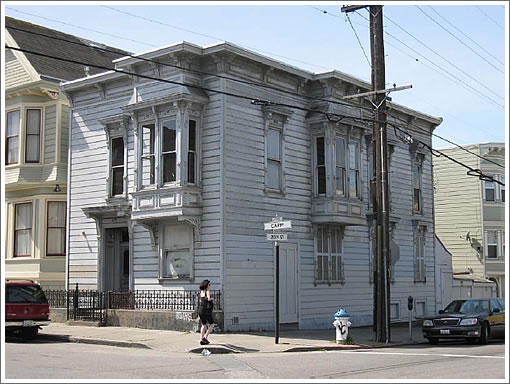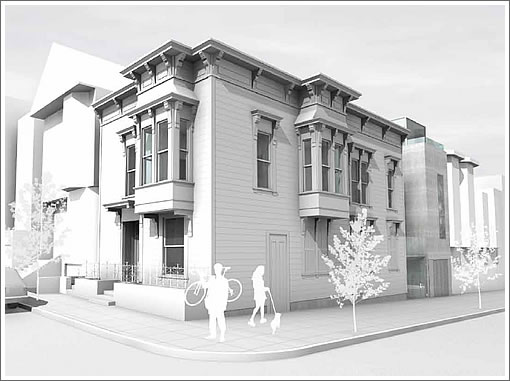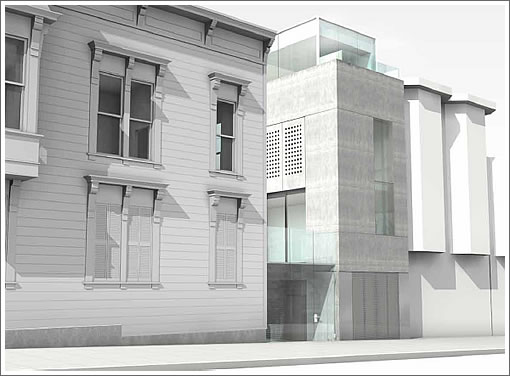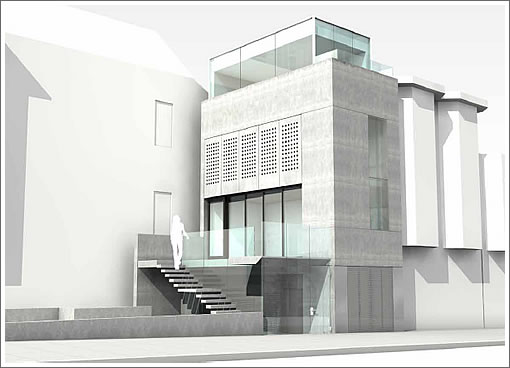
Artist David Ireland passed away in May 2009 a year after selling the 1886 Victorian he had lived in since 1975 and transformed into a work of art residence.
Purchased for $892,058 by Carlie Wilmans, granddaughter of arts benefactor Phyllis Wattis and director of the Phyllis C. Wattis Foundation, in a bid to preserve Ireland’s legacy, the proposal to rehabilitate and preserve 500 Capp Street will be heard this week.

The project will rehabilitate and restore the existing single-family residence, former home of conceptual artist David Ireland, for use as an artist-in-residence program and archive/study center (Community Facility), operated by the 500 Capp Street Foundation.
A free-standing, four-story residential (caretaker’s) unit with one off-street parking space will be constructed at the rear of the parcel. The Zoning Administrator will hear related rear yard, open space, and parking setback on street frontages variance requests for the proposed new building at the rear of the parcel.

The proposed project would result in two residential units (of approximately 2,440 square feet (sf) and 1,150 sf), one off-street parking space, and an approximately 1,320 sf archive/study center (Community Facility) in basement of existing building.

The 500 Capp Foundation proposes to establish an artist-in-residence program with one to two artists occupying and being inspired by the existing house on a short-term residency. Exhibition of artworks related to the artist-in-residence program may occur on a limited basis. The David Ireland archive/study center in basement of existing building will be open by appointment only.
Jensen Architects is leading the architectural charge. And while the project requires a conditional use authorization from the Planning Commission to move forward, the Planning Department recommends the project’s approval (as do we).
Access to 500 Capp Street would be by way of open houses (“space in the house is limited and due to the delicate nature of the house and its’ contents, the open houses would be limited to a set number of people, not to exceed 20 per hour”) and private tours.
∙ David Ireland’s 500 Capp Street: Inside And Soon To Be On The Market [SocketSite]
∙ 500 Capp Street Proposal And Designs [sf-planning.org]
I like the idea of the artist in residency program and the archive and study center devoted to Ireland’s career. But I do not understand why an on site caretaker’s residence needs to be added.
Love the caretaker’s home!
So, acording to the rendering, they’re planning on removing the fire hydrant,the power lines, the parking meters, and the street sign?
“So, acording to the rendering, they’re planning on removing the fire hydrant,the power lines, the parking meters, and the street sign?”
Yes, and they’re also planning on boarding up all the neighboring houses and painting them white.
It’s a rendering. It’s not real life.
invented wrote:
Assuming that’s not just a massing study and it’s intended to be vaguely close to the to-be-built unit…well, let’s just say that Brutalism isn’t being brought back. Brutalism never left.
I’m sure Stanley Saitowitz would approve.
This is wonderful, thanks for the post. I really hope this goes through, it would be a very unique solution and a big addition to the city, not to mention the Mission.
Amusingly, the rendering removed the curb cuts. Rather a no-no, doncha think?
And why will they replace the neighbors with those creepy white ghost people?
funny, passed that place a hundred times when I took my child to the community music center and always wondered about it.
I like the intensely unadorned, modern imposition here — pared down to the functional elements; it lets the corner house be genuinely distinguished on its own. The subtle Vic references work for me — anything else would detract from the corner home and adjacent building.
Related — would like to see similar modern infusion in the three homes proposed for Alamo Square, albeit with more glass on Steiner facade. It would enrich postcard row and the other ornate buildings on Steiner instead of the proposed lukewarm muddled mixed-century derivative concoction which will detract from the existing streetscape.
“Amusingly, the rendering removed the curb cuts. Rather a no-no, doncha think?”
Yes, someone should report this for a violation of the RADA (Rendered Americans with Disabilities Act).
The editing of the overhead lines reminds me of my constant astonishment at the old ugly phone and powerlines that ruin many of the most interesting neighborhood streetscapes. I have seen Third World cities do a quicker job of burying infrastructure and for a city that claims to be on the forward edge, the overhead lines are a reminder of how far behind we are falling on urban infrastructure. I would rather have better transit, bury the overhead lines, and plant more trees instead of an America’s Cup Sailing Center and Artist in Residence dwellings.
Regarding overhead power lines, don’t property owners have to pay?
“The editing of the overhead lines reminds me of my constant astonishment at the old ugly phone and powerlines that ruin many of the most interesting neighborhood streetscapes.”
This is about cash, pure and simple. PG&E will bury the lines for you if you and your neighbors get together to pay for it. Large parts of Pacific Heights have buried lines.
Further amusement: Note that the bike rider has to carry his bike because the curb cuts are gone, and the dog is missing a hydrant to pee on. Pretty droll.
One scheme is that PG&E and the other utilities pay for the main trench along the street and to move the mains down into the trench. Homeowners then pay to move their service connect from the air down to the trench and that includes digging little lateral trenches to the main trench.
This has to be done an entire block at once, so if there are one or a few homeowners unwilling or unable to pay their portion of the lateral work then the remainder of block has to decide whether to subsidize those non-paying homeowners.
Every block has a few homeowners who either cannot or will not pay for the laterals. The pain of carrying the burden of the non-paying neighbors depends on how many and how much compared to your “normal” expenses. So as sfrenegade implies, undergrounding is going to happen more readily in the more affluent neighborhoods. They have fewer non paying neighbors and the pain of carrying their burden is less significant.
I remember when our neighborhood in Southern California had it’s overhead lines buried and I just checked with my parents and it was provided by the city (DWP) and they did not have to organize and pay for the project as it was done without any special charges or requests from homeowners other than no on-street parking for one week during the project. (This was in the 70’s!) When I lived in Chicago (much older city)I rarely saw a street with overhead lines.
So why must we pay extra for what others get as part of their expected service? Undergrounding should be part of required updatinig of infrastructure, but after the recent San Bruno explosion, I suppose we should not expect PG&E to maintain underground lines properly as well. Sigh.
“When I lived in Chicago (much older city)I rarely saw a street with overhead lines.
So why must we pay extra for what others get as part of their expected service?”
The comparison to Chicago probably fails here. Ice and snow storms can wreak more havoc than the relatively mild climate here. We rarely ever have thunderstorms here.
I do wonder why LADWP was willing to underground the lines, however. They certainly haven’t done that everywhere in LA, so maybe it was a limited project.
Was the neighborhood wealthy? The people living there might have had ‘influence’ in the right places.
There was a minor scandal in the east bay where the utility was paying for an undergrounding project in an affluent neighborhood, even though it was significantly more expensive than average (because of the geography) and drained a large part of the budget.
See the old SS thread on undergrounding:
https://socketsite.com/archives/2009/05/stick_em_where_the_sun_dont_shine_and_views_arent_obstr.html
I have seen Third World cities do a quicker job of burying infrastructure and for a city that claims to be on the forward edge, the overhead lines are a reminder of how far behind we are falling on urban infrastructure.
Third World often do a quicker job of builing infrastructure than SF.
No unions, NIMBYs don’t get a voice, no red tape (bribes help),…
joh wrote:
And Third World cities often have to then allocate significant resources digging out dead bodies when 230,000 people die in an earthquake because they were so much “quicker” at building infrastructure than SF.
No licensed contractors, no red tape, no adherence to or enforcement of the building code, hell no building code…
Great to have such a cultural resource in the Mission… especially with its history in the Mission.
The new building is a disappointment. Was hoping for something with Ireland’s spirit of curiosity and revelation. Instead, its pat penetential chic for $750/sq.ft. construction cost.
The guy carrying the bike makes no sense. Who are the people that populate these renderings?
“The guy carrying the bike makes no sense.”
Maybe the dog was peeing on it and he was trying to keep it away…
Due to the fact the dog had no hydrant to pee on.
Yes, it all makes sense now.